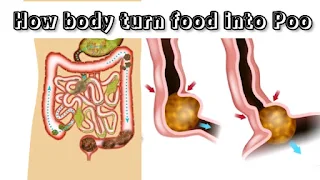HOW DOES YOUR BODY TURN FOOD INTO THE POO HUMAN DIGESTION SYSTEM IN HUMAN BEINGS
Mechanical digestion begins in the mouth as the food is chewed,
Chemical digestion begins in the mouth when food mixes with saliva, saliva contains an enzyme (amylase )that begins the breakdown of carbohydrates, thr epiglottis is a flexible flab at the end of the larynx in the throat.
It acts as a switch between the
larynx and the oesophagus to permit air to enter the airway to the lungs and food to pass into the oesophagus to permit air to enter the airway to the lungs and food to pass into the oesophagus, oesophagus it is a muscular tube connecting the throat with the stomach.
The oesophagus is a about 8 inches long. The oesophagus muscle acts with peristaltic action, to move swallowed food down to the stomach.
The food then enters the stomach which is a rounded, hollow I shape organ located between the oesophagus and the duodenum the stomach has three mechanical tasks to do,
1. The stomach must store the swollen food and liquid,
This requires the muscle of the upper part of the stomach to relax and accept large volumes of swallowed material, the inner layer of the stomach is full of wrinkles known as rugae.
Rugae both allow the stomach to stretch in order to accommodate large meals and help to grip and move food during digestion.
2. Is to mix up the food liquid, with digestive juice produced by the stomach,
The lower part of the stomach mixes these materials as a blender by its muscle action. and breaks down the food to tiny particles in 3 milimiters
3. finally, the stomach empties this acidy mash slowly into the small intestine,
The small intestine or small bowel is an organ in the gastrointestinal tract where most of the end absorption of nutrients and minerals from food takes place,
It lies between the stomach and large intestine duodenum, the first part of the small intestine which receive s partially digested food from the stomach and begins the absorption of nutrients.
The duodenum is the shortest segment of the intestine and is about 23 to 28 cm (9 to 11 inches) long the pancreatic juice and bile that are released into the duodenum help the body to digest fats, carbohydrates, and proteins.
The food is in interim now and have very long way to go as a person grows the small intestine increases 20 times in length from about 200 cm in a newborn to almost 6 m in an adult.
The nine walls of the small intestine show mucosal folds. These are called the place circulates the place are more numerous in the early and educe in number in the later part and are completely absent.
Digestion is important because your body needs nutrients from food and drink to work properly and stay healthy proteins, fats, carbohydrates, vitamins, minerals, and water are nutrients.
Your digestive system breaks nutrients into parts small enough for your body to absorb and use for energy growth, and cell repair What is left over, which is mostly liquid then moves into the colon.
The water is absorbed in the colon bacterial in the colon break down the remaining material, then the colon moves the leftover material into the rectum the rectum is like a storage - holder for this waste.
Muscles in the rectum move the waste, called stool out of the body through the anus.







0 Comments